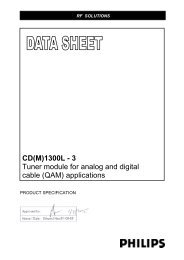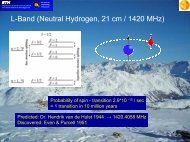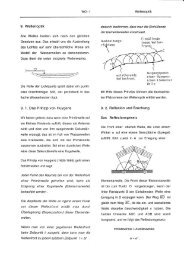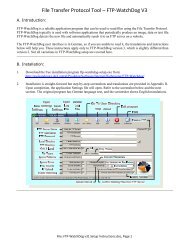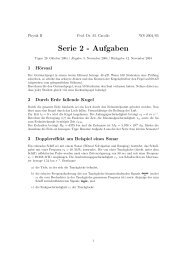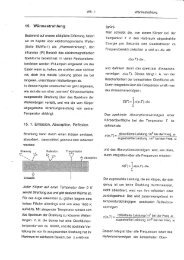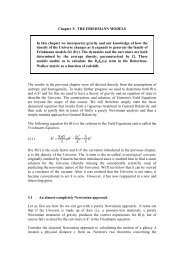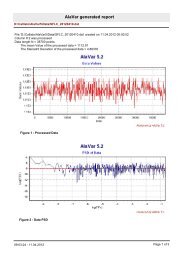here - Institute for Astronomy Umleitung
here - Institute for Astronomy Umleitung
here - Institute for Astronomy Umleitung
You also want an ePaper? Increase the reach of your titles
YUMPU automatically turns print PDFs into web optimized ePapers that Google loves.
Title: Science Case<br />
Reference: MUSE-MEM-SCI-052<br />
Issue: 1.3<br />
Date: 04/02/2004<br />
Page: 15/100<br />
observations <strong>for</strong> the local and z=3 universe. They correspond to a flat or decreasing cosmic<br />
SFR at z>4, <strong>for</strong> which very little data is available. Their predictions should be considered as<br />
quite conservative lower values since it is pretty possible that the cosmic SFR strongly<br />
increases at z>4, maybe by a factor 10 as suggested by the analysis of Lanzetta et al. (2002).<br />
Ultimately, the solution to clarify this point is to obtain the data with MUSE.<br />
We assume that Ly α photons are produced by ionized regions (case B recombination). In such<br />
models, the description of the Ly α line is particularly delicate, because of the existence of<br />
stellar absorption after a starburst (due to A stars), and of resonant scattering. Only a small<br />
fraction of the emitted Ly α photons should escape from a homogeneous dusty medium.<br />
Nevertheless, Ly α emission is observed in local objects (such as Blue Compact Dwarfs) and<br />
high-redshift galaxies (Ly-break galaxies and Ly α galaxies found in wide-field, narrow-band<br />
surveys). It is thought that the existence of an expanding medium prevents Ly α photons from<br />
resonant scattering, and produces characteristic P-Cygni profiles. T<strong>here</strong> is no simple<br />
modelling of such a process. At the current stage, we make predictions <strong>for</strong> two different<br />
models: (i) a fixed escape fraction f esc which would correspond to «holes» in the gas and dust<br />
distribution, and that is normalised in order to reproduce number counts obtained by current<br />
surveys; (ii) absorption in a dusty<br />
medium without resonant scattering<br />
(let’s say, if the velocity of the<br />
expanding medium is high enough to<br />
completely hamper resonant scattering).<br />
A more realistic model is clearly needed.<br />
It is <strong>for</strong>eseen that the interpretation of<br />
current Ly α surveys and the preparation<br />
of MUSE will foster theoretical activity<br />
on this point.<br />
T<strong>here</strong> is very little observational<br />
constraint on the value of the Ly α escape<br />
fraction. Steidel et al. (2001) give f esc ≥<br />
0.07–0.1 from Ly-break galaxy spectra,<br />
but it is very likely that stellar<br />
populations at higher redshifts are<br />
younger, less chemically evolved and<br />
less dusty. We choose to fix f esc in order<br />
to reproduce current Ly α surveys. At<br />
z=3.4, the observed surface density of<br />
reasonable confirmed objects at the<br />
2.10 -17 erg.s -1 .cm -2 flux level is 12,000<br />
deg -2 (∆z) –1 , that is, 3.3 arcmin -2 (∆z) –1 .<br />
This is obtained with f esc =0.15. This<br />
number appears reasonable in the light<br />
of more specific studies that take into<br />
account plausible values <strong>for</strong> the covering<br />
factor and metallicity (e.g. Haiman &<br />
Spaans 1999). The decrease of<br />
Figure 2-2: Predictions of faint galaxy counts in<br />
three redshift bins with the GalICS model. The<br />
escape fraction <strong>for</strong> Ly α photons is fixed in order to<br />
reproduce the current counts at a flux limit of<br />
2.10 -17 erg.s -1 .cm -2 in a redshift slice at z=3.4. Solid<br />
dots show the results of the recent surveys taken<br />
from Table 2-1 (error bars are only Poissonian).<br />
The effect of clustering on the cosmic variance<br />
appears from the scatter of the points. The model<br />
seems to scale fairly with redshift. The open<br />
triangle shows an estimate based on a single lensed<br />
source at a redshift z=5.7. The MUSE Deep Field<br />
flux limit is also shown




